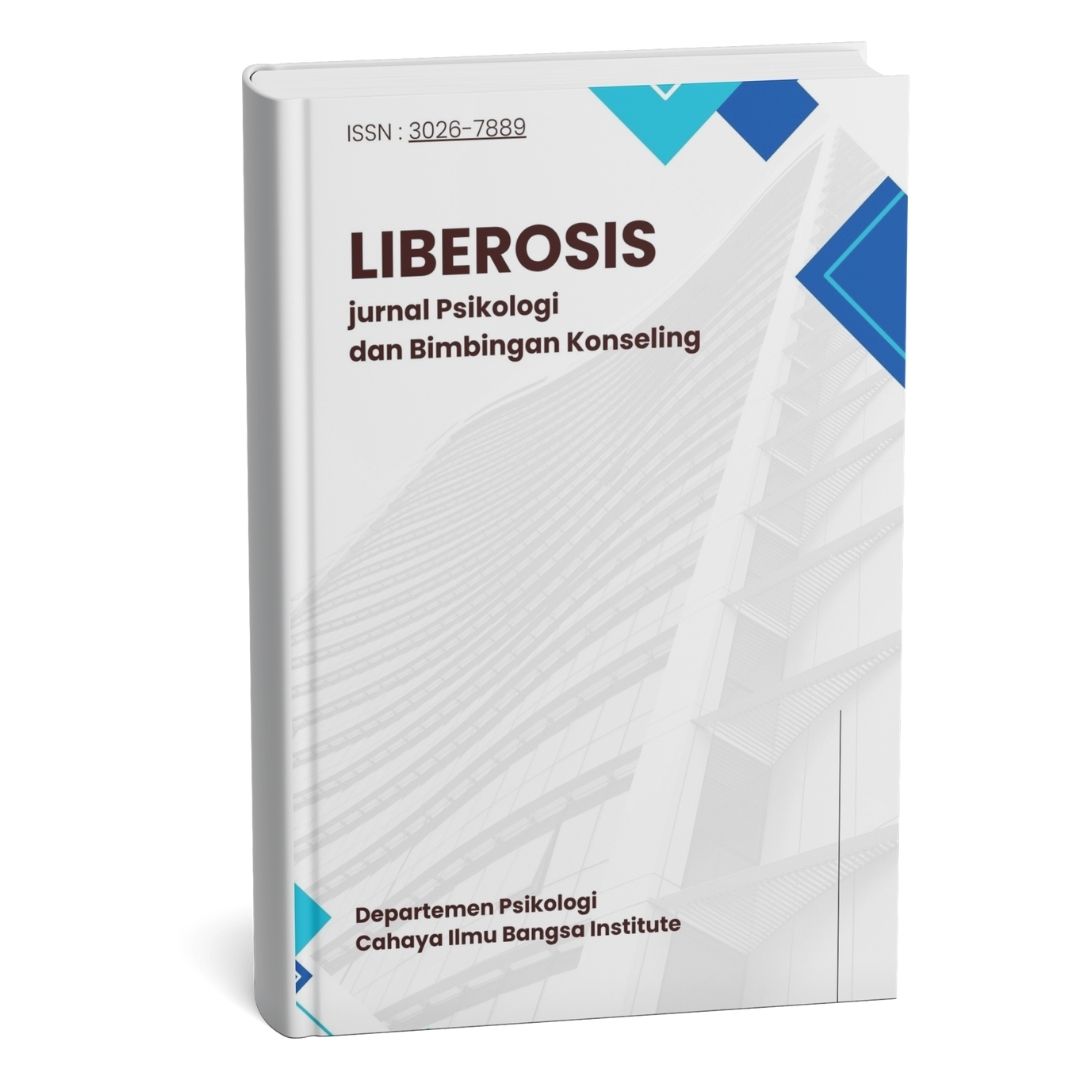HUBUNGAN ANTARA PERILAKU PHUBBING DENGAN INTERAKSI SOSIAL DI DUNIA NYATA PADA PEKERJA
Main Article Content
Abstract
Researchers are interested in conducting research related to phubbing behavior with social interaction in workers, so that workers or other communities can pay more attention to the real world than the virtual world. In this study, the number of samples was taken from the selected population of workers. The purpose of this study was to determine the relationship between two variables, namely Phubbing Behavior and Social Interaction in the Real World in Workers at PT X with a total of 156 respondents and the selected subjects were 108 respondents, the selection was randomly selected using simple random sampling technique. The research method used is quantitative method. This study focuses on analyzing the relationship between phubbing behavior and social interaction in the real world in workers. The results of this study indicate that there is a positive relationship between Phubbing Behavior and Social Interaction. This can be proven by the results of data analysis using Spearman rho with a coefficient value of 0.746 with a significance level of 0.000 <0.05 which shows that there is a very significant positive correlation between the phubbing behavior variable and social interaction.
Keywords: phubbing, social interaction, workers
Abstrak
Peneliti tertarik untuk melakukan penelitian terkait perilaku phubbing dengan interaksi sosial pada pekerja, sehingga pekerja atau masyarakat lainnya dapat lebih memperhatikan dunia nyata daripada dunia maya. Pada penelitian ini, jumlah sampel diambil dari populasi pekerja yang terpilih. Tujuan dari penelitian ini untuk mengetahui hubungan antara dua variabel yaitu Perilaku Phubbing dengan Interaksi Sosial di Dunia Nyata pada Pekerja di PT. X dengan jumlah 156 responden dan dan subjek yang terpilih berjumlah 108 responden, pemilihan tersebut dipilih dengan acak menggunakan teknik simple random sampling. Motede penelitian yang digunakan ialah metode kuantitatif. Pada penelitian ini memiliki fokus pada analisis hubungan antara perilaku phubbing dengan interaksi sosial di dunia nyata pada pekerja. Hasil penelitian ini menandakan bahwa terdapat hubungan yang positif antara Perilaku Phubbing dengan Interaksi Sosial. Hal tersebut dapat dibuktikan dengan hasil analisis data menggunakan Spearman rho dengan nilai koefisien 0,746 dengan taraf signifikansi 0,000 < 0,05 yang menunjukkan bahwa adanya korelasi kearah positif yang sangat siginifkan antara variabel perilaku phubbing dengan interaksi sosial.
Kata Kunci: phubbing, interaksi sosial, pekerja
Article Details
Section
How to Cite
References
Aditia, R. (2021). Fenomena Phubbing: Suatu Degradasi Relasi Sosial Sebagai Dampak Media Sosial. KELUWIH: Jurnal Sosial Dan Humaniora, 2(1), 8–14. https://doi.org/10.24123/soshum.v2i1.4034
Al Saggaf, Y., & O’Donnell, S. B. (2019). Phubbing: Perceptions, reasons behind, predictors, and impacts. Human Behavior and Emerging Technologies, 1(2), 132–140. https://doi.org/10.1002/hbe2.137
Atmaja, I. G. N. A., & Alvin, M. F. (2023). Perilaku penggunaan smartphone dan dampaknya terhadap relasi sosial pekerja Gen Z dan Y. Jurnal Ilmu Sosial Terapan, 7(2), 112–123. https://jist.publikasiindonesia.id/index.php/jist/article/view/665
Azwar, S. (2018). Reliabilitas dan validitas (Edisi ke 4). Yogyakarta: Pustaka Pelajar.
Chotpitayasunondh, V., & Douglas, K. M. (2018). The effects of “phubbing” on social interaction. Journal of Applied Social Psychology, 48(1), 1–13. https://doi.org/10.1111/jasp.12506
Duke, É., & Montag, C. (2017).
Smartphone addiction, daily interruptions and self-reported productivity.
Addictive Behaviors Reports, 6, 90–95.
https://doi.org/10.1016/j.abrep.2017.07.002
Fabli, I. (2022). Hubungan interaksi sosial dengan kohesivitas kelompok pada anggota Ikatan Mahasiswa Pemuda Pelajar Simeulue Barat di Banda Aceh (Skripsi Sarjana). Universitas Islam Negeri Ar Raniry, Banda Aceh. https://repository.ar raniry.ac.id/id/eprint/22459
Fadilah, A., Amanda, R., Rini, P., Pratitis, N., & Psikologi, F. (2022). Perilaku phubbing pada remaja: Menguji peranan kontrol diri dan interaksi sosial. INNER: Journal of Psychological Research, 2(2), 150– 159.
Frackowiak, T., Smith, A. L., & Zhao, Y. (2024). Cellphone relevance hypothesis and social impact of phubbing. SAGE Open, 14(2), 1–12. https://doi.org/10.1177/21582440241298271
Gentina, E., Maille, V., & Li, Y. (2018). A cross-national study of nomophobia among Brazilian, Chinese, French, and U.S. young people: The role of materialism. Journal of Marketing Theory and Practice, 26(4), 360–375. https://doi.org/10.1080/10696679.2018.1488214
Ghozali, I. (2020). Aplikasi analisis multivariat dengan program IBM SPSS 25 (Cetakan ke 10). Semarang: Badan Penerbit Universitas Diponegoro.
Karadaǧ, E., Tosuntaş, Ş. B., Erzen, E., Duru, P., Bostan, N., Şahin, B. M., Çulha, I., & Babadaǧ, B. (2015). Determinants of phubbing, which is the sum of many virtual addictions: A structural equation model. Journal of Behavioral Addictions, 4(2), 60–74. https://doi.org/10.1556/2006.4.2015.005
Kurnia, S., Sitasari, N., & Safitri. (2020). Kontrol diri dan perilaku phubbing pada remaja di Jakarta. Jurnal Psikologi : Media Ilmiah Psikologi, 18(1), 58–67.
Lestari, D. A., Thuba, A., & Priyanggasari, S. (2022). Hubungan Perilaku Phubbing dengan Interaksi Sosial pada Mahasiswa di Kota Malang. Seminar Nasional Sistem Informasi, 6(1), 3634–3644. https://jurnalfti.unmer.ac.id/index.php/senasif/article/view/445
Misnah, S., Abidin, M. Z., & Mubarak, M. (2021). Intensitas penggunaan gadget terhadap interaksi sosial mahasiswa Psikologi Islam UIN Antasari Banjarmasin. Jurnal Al Husna, 1(3), 237–248. https://doi.org/10.18592/jah.v1i3.4238
Nazir, T., & Bulut, S. (2019). Phubbing and what could be its determinants: A dugout of literature. Psychology, 10(6), 819–829. https://doi.org/10.4236/psych.2019.106053
Rakhmat, J. (2012). Psikologi komunikasi. Bandung: Remaja Rosdakarya.
Retalia, R., Soesilo, T. D., & Irawan, S. (2022). Pengaruh penggunaan smartphone terhadap interaksi sosial remaja. Scholaria: Jurnal Pendidikan dan Kebudayaan, 12(2), 139–149. https://doi.org/10.24246/j.js.2022.v12.i2.p139-149
Roberts, J. A., & David, M. E. (2016). My life has become a major distraction from my cell phone: Partner phubbing and relationship satisfaction among romantic partners. Computers in Human Behavior, 54, 134–141. https://doi.org/10.1016/j.chb.2015.07.058
Rosdiana, Y., & Hastutiningtyas, W. R. (2017). Generasi Z Mahasiswa Keperawatan Universitas Tribhuwana. Jurnal Kesehatan Mesencephalon, 2020(1), 42–47.
Sari, N. P. (2022). Dampak wfh terhadap interaksi sosial karyawan pada perusahaan y di kota yogyakarta. Jurnal Kewarganegaraan, 6(3), 5435– 5440.
Sarwono, S. W. (2010). Psikologi sosial: Interaksi sosial. Jakarta: Salemba Humanika.
Siti Rahma Harahap. (2020). Proses Interaksi Sosial Di Tengah Pandemi Virus Covid 19. Al-Hikmah Media Dakwah, Komunikasi, Sosial Dan Kebudayaan, 11(1), 45–53. https://doi.org/10.32505/hikmah.v11i1.1837
Soekanto, S. (2010). Sosiologi: Suatu pengantar. Jakarta: Rajawali Pers. https://id.scribd.com/document/ISBN 979 421 009 9
Solikhah, N. I., & Aesthetika, N. M. (2022). Pengaruh Intensitas Penggunaan Aplikasi Tiktok dan Media Sosial terhadap Kecenderungan Phubbing. Warta ISKI, 5(1), 113–119. https://doi.org/10.25008/wartaiski.v5i1.140
Sugiyono. (2017). Metode penelitian kuantitatif, kualitatif, dan R&D (Edisi ke X). Bandung: Pustaka Alfabeta.
Youarti, I. E., & Hidayah, N. (2018). Perilaku phubbing sebagai karakter remaja generasi Z. [Seminar nasional/artikel].
